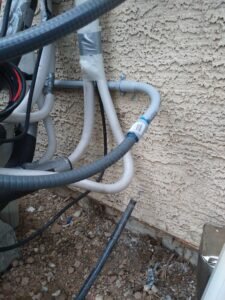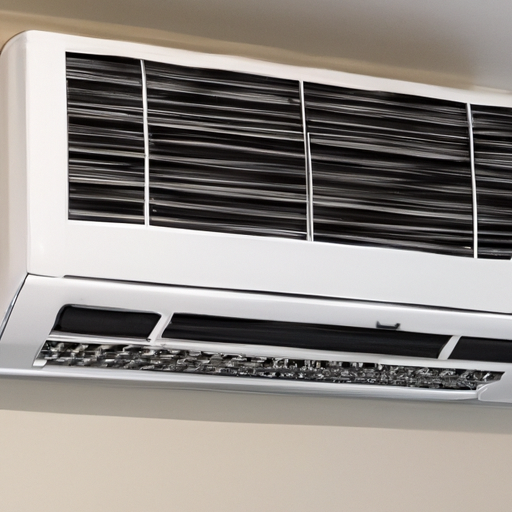This article examines the effectiveness of ductless mini-split systems in cooling and dehumidifying a room. Mini split heating and cooling systems have become increasingly popular in various applications, including residential homes, garages, work sheds, and large buildings like warehouses. However, the question remains: Can these systems effectively cool and dehumidify a room? By exploring the features and capabilities of ductless mini-split systems, this article aims to shed light on this query and provide insights into their performance in maintaining a comfortable indoor environment.

Overview of Ductless Mini-Split Systems
Definition and Functioning of Ductless Mini-Split Systems
A ductless mini-split system, also known as a mini-split heat pump, is a type of heating, ventilation, and air conditioning (HVAC) system that provides both cooling and heating functions without the need for ductwork. It consists of an outdoor unit that houses the compressor and condenser, and one or more indoor units mounted on walls or ceilings. These indoor units are connected to the outdoor unit by refrigerant lines, allowing for efficient and effective cooling and heating of individual rooms or zones.
Types and Components of Ductless Mini-Split Systems
There are two main types of ductless mini-split systems: single-zone and multi-zone.
A single-zone system consists of one outdoor unit and one indoor unit, providing cooling and heating for a single room or area. On the other hand, a multi-zone system consists of one outdoor unit and multiple indoor units, allowing for the cooling and heating of multiple rooms or areas independently.
The components of a ductless mini-split system include the outdoor unit, indoor unit(s), refrigerant lines, and a remote control or wall-mounted thermostat for controlling the system’s temperature and settings. Some advanced models may also include additional features such as built-in air purifiers, Wi-Fi connectivity, and smart home integration.
Cooling Mechanism of Ductless Mini-Split Systems
How Ductless Mini-Split Systems Cool a Room
When it comes to cooling, ductless mini-split systems function similarly to traditional air conditioners. The refrigerant, a chemical substance that absorbs and releases heat, flows between the outdoor unit and the indoor unit(s) through the refrigerant lines.
The cooling process begins when the indoor unit‘s evaporator coil absorbs heat from the room, cooling the air. This cooled air is then distributed back into the room through the indoor unit’s fan. Meanwhile, the absorbed heat is transferred to the outdoor unit‘s condenser coil where it is released into the outdoor air.
Benefits of Cooling with Ductless Mini-Split Systems
Cooling a room with a ductless mini-split system offers several advantages.
Firstly, since ductwork is not required, installation is typically simpler and less invasive compared to traditional HVAC systems. This can lead to cost savings and reduced installation time.
Secondly, ductless mini-split systems allow for zone-specific cooling, meaning you can set different temperatures for each room or zone. This level of customization ensures optimal comfort and energy efficiency.
Furthermore, ductless mini-split systems are known for their quiet operation. The indoor units are designed to minimize noise, providing a peaceful and comfortable environment.
Lastly, ductless mini-split systems tend to be more energy-efficient compared to window units or central air conditioners. This is due to the absence of ductwork, which can result in energy loss through leaks and inefficient airflow.
Dehumidification Process of Ductless Mini-Split Systems
The Role of Ductless Mini-Split Systems in Dehumidification
In addition to cooling, ductless mini-split systems are capable of effectively dehumidifying a room. Excess humidity in indoor spaces can make the air feel heavy and uncomfortable, and it can also contribute to mold and mildew growth.
During the cooling process, a ductless mini-split system removes moisture from the air as it passes over the evaporator coil. The evaporator coil is colder than the room air, causing the humidity to condense into liquid water. This condensed water is then drained out of the system, effectively reducing the overall humidity level in the room.
Advantages of Dehumidifying with Ductless Mini-Split Systems
Dehumidification with a ductless mini-split system offers several benefits.
Firstly, maintaining proper humidity levels is essential for indoor comfort. By removing excess moisture from the air, a ductless mini-split system can create a more comfortable living or working environment.
Secondly, controlling humidity is crucial for preventing the growth of mold and mildew. These microorganisms thrive in humid conditions and can negatively impact indoor air quality and the health of occupants. By dehumidifying the room, ductless mini-split systems help inhibit the growth of mold and mildew.
Furthermore, dehumidifying with a ductless mini-split system can contribute to energy savings. When the air is less humid, it feels cooler, allowing for higher thermostat settings and reduced energy consumption. This can result in lower energy bills, making ductless mini-split systems a cost-effective choice.
Factors Affecting the Cooling and Dehumidification Performance
Room Size and Layout
The size and layout of the room or area being cooled or dehumidified are important factors that influence the performance of a ductless mini-split system. Larger rooms may require higher cooling capacities to maintain comfort, while smaller rooms may need lower capacities. Additionally, the layout of the space, such as open-concept designs or multiple partitions, can affect airflow and cooling distribution, thereby impacting the overall performance.
Insulation and Air Sealing
The insulation and air sealing of the room or building can significantly affect the cooling and dehumidification performance of a ductless mini-split system. Poor insulation and air leaks can result in energy loss and reduced efficiency. It is important to ensure proper insulation and air sealing to maximize the system’s effectiveness and energy savings.
Outdoor Climate Conditions
The outdoor climate conditions, such as temperature and humidity levels, can also impact the cooling and dehumidification performance of a ductless mini-split system. Extremely high outdoor temperatures or high humidity levels may require the system to work harder to achieve the desired indoor conditions. It is important to consider the local climate when selecting and sizing a ductless mini-split system.

Sizing and Placement of Ductless Mini-Split Systems
Determining the Proper Size and Capacity
Proper sizing is crucial for the optimal performance of a ductless mini-split system. Undersized systems may struggle to cool or dehumidify a room effectively, while oversized systems may cycle on and off frequently, resulting in inefficient operation and potential temperature fluctuations.
To determine the proper size and capacity, factors such as the room’s square footage, insulation levels, number of occupants, and heat-generating appliances should be taken into consideration. It is recommended to consult with a professional HVAC technician to accurately size the system and ensure it meets the specific cooling and dehumidification needs of the space.
Optimal Placement for Cooling and Dehumidification Efficiency
The placement of the indoor units plays a crucial role in maximizing cooling and dehumidification efficiency. Ideally, the units should be installed in locations that allow for even air distribution and coverage throughout the room or zone. Placement near areas where heat is generated, such as electronics or appliances, can help improve cooling performance. Additionally, proper airflow should be ensured by avoiding obstructions and allowing adequate space around the units for air circulation.
Energy Efficiency of Ductless Mini-Split Systems
Comparison with Traditional HVAC Systems
Ductless mini-split systems are generally considered more energy-efficient compared to traditional HVAC systems, such as central air conditioners or furnaces. This is due to several factors, including the absence of ductwork and the ability to control individual zones.
Traditional HVAC systems rely on ductwork to distribute conditioned air, which can result in energy loss through leaks and inefficient airflow. In contrast, ductless mini-split systems eliminate the energy loss associated with ductwork, leading to higher energy efficiency.
Furthermore, traditional HVAC systems typically operate on a fixed-speed compressor, which means they constantly run at maximum capacity. Ductless mini-split systems, on the other hand, utilize inverter technology that allows the compressor to adjust its speed based on the cooling or heating demand. This variable-speed operation reduces energy consumption, resulting in additional energy savings.
Inverter Technology and Energy Savings
Inverter technology is a key feature of ductless mini-split systems that contributes to their energy efficiency. The inverter technology enables the compressor to operate at variable speeds, adjusting its output to match the cooling or heating requirements of the room.
By automatically adjusting the compressor’s speed, the system avoids the energy-intensive cycles of traditional HVAC systems that repeatedly turn on and off. This results in reduced energy consumption and improved overall energy efficiency. Inverter technology also helps maintain a more stable indoor temperature, avoiding temperature fluctuations often experienced with traditional systems.

Maintenance and Care for Optimal Performance
Regular Cleaning and Filter Replacement
To ensure optimal performance and longevity, regular cleaning and filter replacement are essential for ductless mini-split systems. Dust, dirt, and other particles can accumulate on the indoor unit’s filters and coils, obstructing airflow and reducing efficiency. It is recommended to clean or replace the filters every few months, or as instructed by the manufacturer. Additionally, the outdoor unit should be kept free of debris, such as leaves or vegetation, to maintain proper airflow.
Professional Inspections and Tune-ups
In addition to regular cleaning and filter replacement, professional inspections and tune-ups are important for maintaining the optimal performance of ductless mini-split systems. HVAC technicians can identify and address any potential issues before they become major problems, ensuring the system operates efficiently and reliably. These inspections typically include checking refrigerant levels, inspecting electrical connections, and lubricating moving parts, among other maintenance tasks.
Limitations and Drawbacks of Ductless Mini-Split Systems
Limited Cooling Capacity for Large Spaces
While ductless mini-split systems are highly effective for cooling and dehumidifying individual rooms or small areas, they may have limited cooling capacity for larger spaces. In such cases, multiple units may be required to adequately cool the entire area, which can contribute to higher installation and maintenance costs.
Higher Initial Cost Compared to Window Units
Compared to window units, ductless mini-split systems generally have a higher upfront cost. The cost of the system itself, installation, and additional indoor units can add up, especially for multi-zone systems or larger spaces. However, it is important to consider the long-term energy savings and benefits of ductless mini-split systems, which can outweigh the initial investment over time.

Case Studies and Customer Reviews
Real-Life Experiences with Ductless Mini-Split Systems
Many homeowners and businesses have reported positive experiences with ductless mini-split systems. These systems have proven to be effective in cooling and dehumidifying individual rooms or areas, providing customized comfort and energy efficiency. Customers have praised the quiet operation, improved indoor air quality, and overall performance of ductless mini-split systems. Case studies have also demonstrated significant energy savings and reduced environmental impact when compared to traditional HVAC systems.
Conclusion
Ductless mini-split systems offer an effective and efficient solution for cooling and dehumidifying rooms or small areas. With their ability to provide customized comfort, energy efficiency, and quiet operation, ductless mini-split systems have gained popularity among homeowners and businesses alike. While they may have limitations for large spaces and come with a higher initial cost, the long-term benefits and advantages make them a valuable investment. With proper sizing, placement, and maintenance, ductless mini-split systems can effectively cool and dehumidify a room, providing optimal comfort and indoor air quality.


